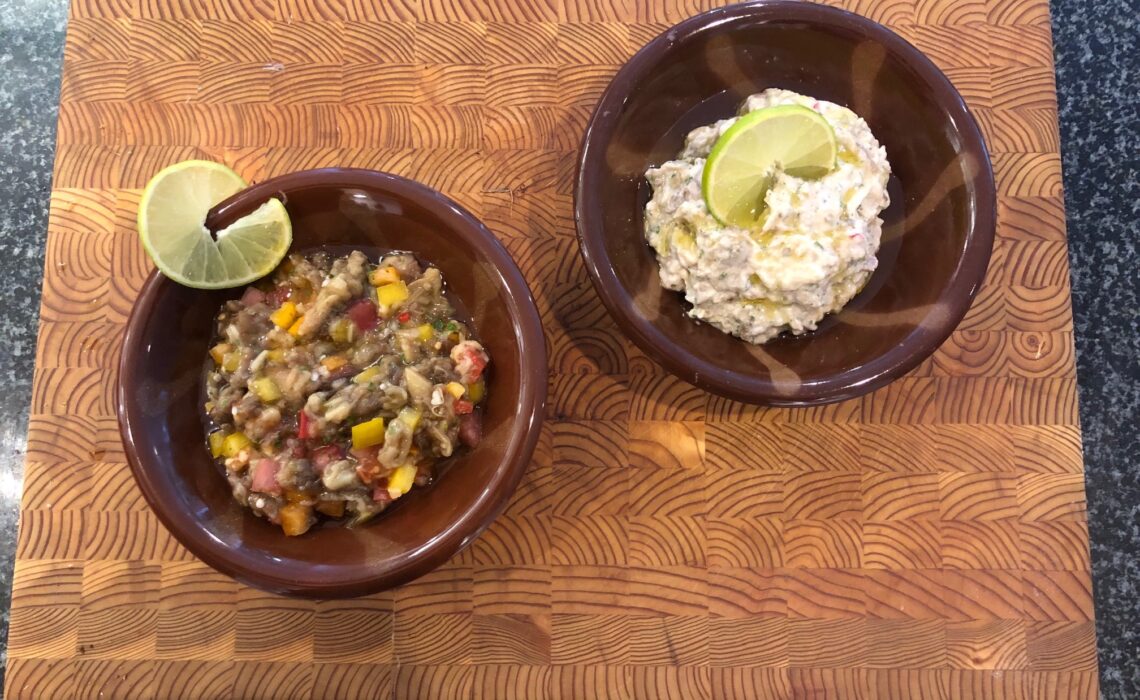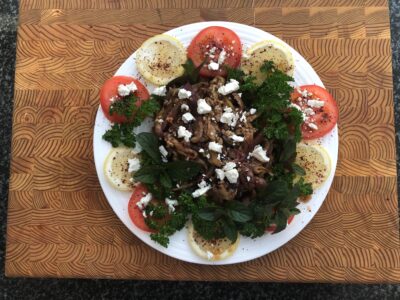
There is a realistic danger that you may sue me for wrongly and maliciously claiming that this dish is simple, when it actually is not. Please bear with me and I will explain.
Baba Ghanouge (let’s call it BG from here on), has a main ingredient of aubergine (eggplant for our friends in North America), which is roasted or baked whole until the outer skin is literally burnt and the inside is soft. The aubergine can also be griddled in slices brushed with olive oil. So, between the different ways of cooking the aubergine and variation of other ingredients gives a false impression of the complexity of the humble BG.
The other factor that unfairly suggests complexity are the unfamiliar and quite bizarre names given to the various derivatives of BG.
We will come to the names later but first, let me help you buy the right type of aubergine. The vegetable must be deep purple, almost black in colour with a wonderful sheen. It must be firm to the touch without skin wrinkles. Always go for the relatively slim long variety rather than the squat round ones. If you are able to find such a vegetable in the supermarket, go ahead and buy otherwise, go elsewhere or postpone the project until you find the right aubergines. Finally, when you are choosing between two aubergines, you must know how to sex them. Yes, I said ‘sex them’. This is to determine whether an aubergine is male or female. To be honest, either will do however, there is a trade off here. The female aubergine is sweeter than the male one (no surprises there). On the other hand, the male aubergine has less seeds inside than the female one and while edible, the seeds are less tasty than the flesh of the aubergine.
To keep you in suspense, I will tell you how to sex an aubergine at the end of this blog.
Now for the names. Baba Ghanouge is a variation on the aubergine dip distinguished by the fact that it does not have tahini (sesame seed paste) as an ingredient. If you add tahini to the preparation, then it assumes a totally different name most commonly known as ‘Mutabbal’. When you further embellish the BG with additional ingredients, it assumes yet another new name (mostly popular in Lebanon) and it is called ‘Saltat el Raheb’. The above three variations are prepared using roasted / baked aubergines. Should you decide to griddle sliced aubergine, then a new name is introduced and all of a sudden you are dealing with ‘Mufassakh’. I have no doubt that, with further research, I might identify a fifth name but, four is plenty to establish your credentials as an aubergine dip connoisseur.
With such deep knowledge of this delicious dip, you can frequent any Middle Eastern restaurant and impress both your fellow diners and restaurant staff to the extent that the chef will go the extra mile to prepare for you an extra special BG, Mutabbal, or Saltat el Raheb. If however, you mention Mufassakh, you are almost certain to have the chef make a personal appearance at your table to humbly ask you for the recipe! This is when you become a legend in your own lunchtime.
There is something satisfying about going to a foreign cuisine restaurant and speaking with authority on the various choices on the menu. I remember once being invited by my wonderful niece ‘Samar’ to a Japanese restaurant in Amman where she ordered for both of us an amazing selection of sushi and sashimi. Samar knew her Japanese food because she worked as a diplomat at the Jordanian Embassy in Tokyo for a number of years and she fell in love with the country and its culture, including their cuisine.
But I digress so, back to our dips. Here are some more secrets of BG and its cousins. If you follow these tips you are sure to enhance your final result and elevate your dip-making skills to a legendary status.
- Always use best quality ingredients, from the aubergine, right down to the herbs and sea salt; they really make a difference to the final outcome.
- When cooked, the aubergine is very delicate and requires careful handling.Avoid mashing, whisking or even over mixing. This is a case of less is more.
- If you decide to roast / bake or scorch your aubergine on open fire, keep the aubergine whole and do not be tempted to make holes in the vegetable with a fork or knife.Some recipes claim that if you don’t make these holes, the aubergine will explode! I don’t pierce aubergines and I have never experienced an exploding one.
- Do not roast the aubergine slowly on low heat, this is one time where relatively high heat is desirable to scorch the skin and create this out-of-this-world smoky aroma.As the aubergine gains heat, the skin will first blister, then a couple of holes will appear, and some juice will escape. This is good, keep your nerves and make sure you continue to roast until the aubergine collapses and loses its original shape.
- Never prepare this dip until the cooked aubergine has completely cooled down.I advise you to place the hot aubergine in a colander and let it cool and lose some of the retained fluid as it cools down.
- To extract the cooked flesh of the aubergine, in my view, is the most delicate and important part of the entire operation.You must make sure you get rid of every last bit of skin because it will spoil the taste of the final dip. I am afraid I suffer from OCD when it comes to this particular step. If I could be sure my family would not commit me to a mental institution, I would have acquired a pair of tweezers to pick out every last slither of skin. Admittedly, we are not dealing with a highly toxic pufferfish but, trust me on this one, take your time and do it properly.
- Cut the head of the cooked aubergine (about 4cm down the length) and set aside as this tends to remain harder than the rest of the aubergine.The best way to get rid of the head of an aubergine is to pick it up by the green stem and biting out the firm flesh inside. This will give you a rush equivalent to smoking a couple of joints! Anyone nearby who is familiar with roasting aubergines will drift into the kitchen, hoping to get one or two heads to bite at. Do not pretend you threw them away; your lips will have black marks from the scorched skin of the aubergine you have just beheaded!
- Lay the aubergine flat on a clean chopping board and open up like a book.Scrape out the flesh gently using the edge of a spoon, avoiding any bits of the outer skin.
- Using a knife in an up/down movement, chop the aubergine into fairly rough chunks but, do not be tempted to mash the whole thing into a paste, you will take away 50% of the desired taste.
- If you decide to make the fourth variation of Mufassakh, then you need to griddle the aubergine in slices of about 1.5 cm thickness.
- Between them the four aubergine dips demand a long list of ingredients some are common to all of them and some are specific to one of them.You will need: sea salt, lemons, garlic, onions/ spring onions, parsley, mint, tahini, tomatoes, sweet peppers (any colour), pomegranate seeds, pomegranate molasses, extra virgin olive oil, and sumac.
- Mutabbal needs lemon juice, sea salt, crushed garlic, chopped parsley and tahini. All ingredients (except the aubergine are mixed into a dressing before adding the chopped aubergine and gently folded to achieve consistency of final mix.
- Baba Ghanouge needs lemon juice, sea salt, crushed garlic, chopped parsley, finely chopped sweet onion/spring onions, small diced tomato, and small diced sweet pepper. Make the same basic dressing as the Mutabbal above (without tahini). In a separate bowl, mix the chopped onions, tomatoes, parsley, and sweet pepper to the roughly chopped aubergine. Fold this mix with the dressing until you achieve the necessary consistency of appearance and taste.
- Saltat El Raheb needs the same ingredients as Baba Ghanouge plus, chopped fresh or dry mint, pomegranate seeds, as well as pomegranate molasses, and sumac. Make the same basic dressing mix as the BG above, plus the pomegranate molasses. Gently mix the roughly chopped aubergine and pomegranate seeds and carefully fold the dressing until you get the right consistency.
- Mufassakh needs sliced tomatoes, lemon juice, sea salt, crushed garlic, sumac, pomegranate molasses, parsley, chopped fresh or dry mint. Mix all dressing ingredients, leaving the aubergine strips, sliced tomatoes, and parsley. Place the aubergine strips on a bed of parsley leaves surrounded by slices of tomato. Spread the dressing mostly over the aubergine strips and some over the tomatoes. Drizzle olive oil over the entire arrangement and sprinkle some sumac for a final touch.

Mufassakh
There you have it. Once you tasted any of these dips, your taste buds will feel like they have just danced the waltz with the Fred Astaire of vegetables, aubergine/eggplant.
So, how do you sex an aubergine? Pick it up and look at the bottom / base of the vegetable. The deep purple shiny skin tapers to a small greenish spot. If this spot is round, then you are handling a male aubergine. If however, the spot is elongated, then you have a female aubergine.
Now, aren’t you glad you decided to read this blog?
If you would like my detailed recipes for the four dips, please let me know and I will send you a copy with detailed ingredients and step by step instructions for each dish.
Mufid Sukkar – May 2020



Well I thought I knew my inions but obviously not!!! I have been making what I thought was Muttabel for years. Almost the same recipe as yours and definitely no whisking or beating but rather fine chopping with a sharp knife using the rocking technique. But ….here is the difference. I always ad some yoghurt to the tahini before adding the aubergine. We love it but does that have a name?
Hi Lottie,
There is no other name for your variant. Yoghurt is normally used with tahini to make it more malleable and essentially thinner. You also end up with lighter, whiter looking dip. But, you still end up with basically the same ‘Mutabbal’ dip.
Yummo! I’m going to try the other varieties soon! Thanks for the tips xxx
p.s I have no interest in the gender of my aubergine. I will assume they’re all gender neutral